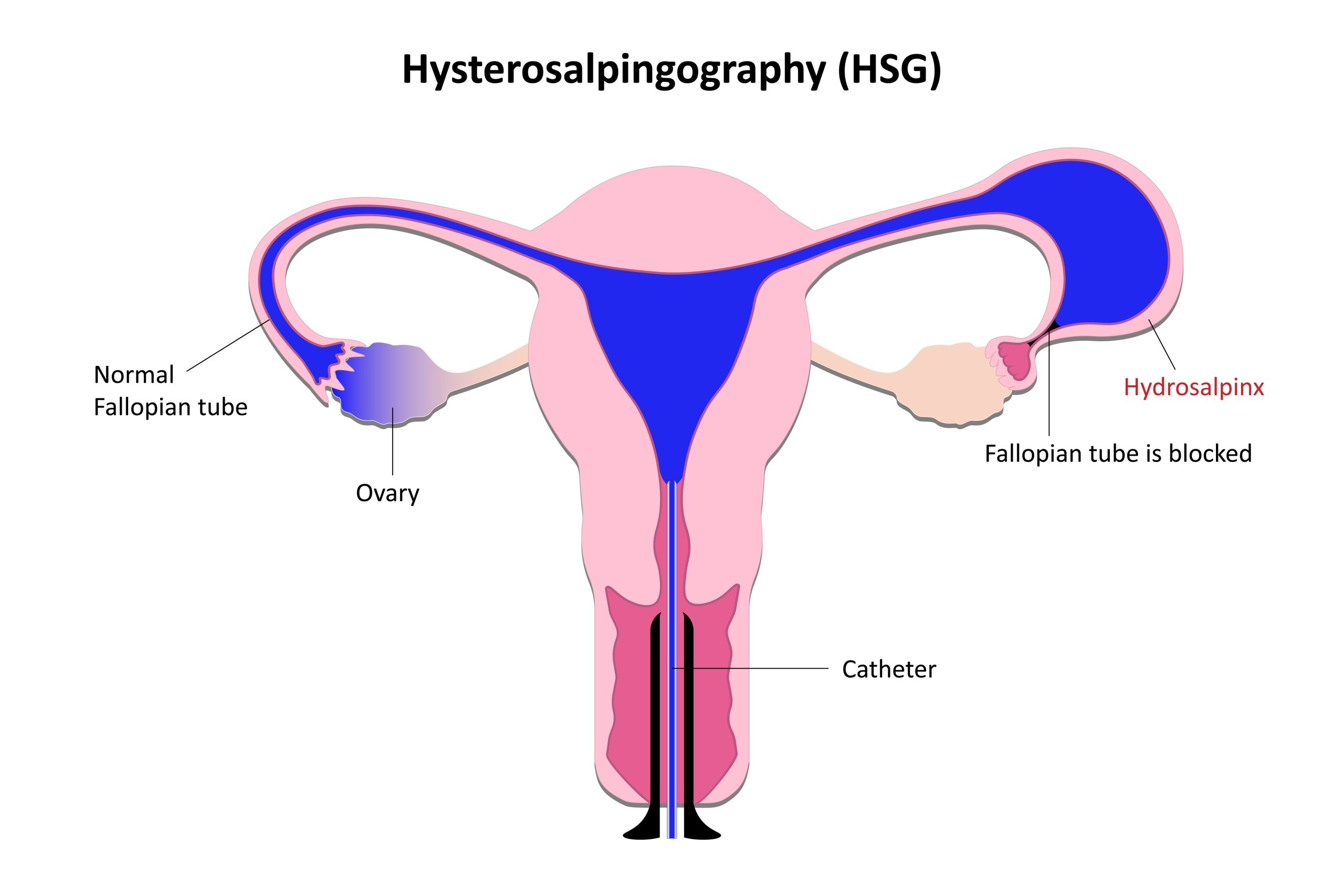What is a Hysterosalpingogram (HSG)? Uses and Benefits

A hysterosalpingogram (HSG) is a simple diagnostic X-ray procedure that determines whether the fallopian tubes are open and assesses the presence and condition of fibroids or polyps in the uterine cavity. Hystero-salpingo-gram, literally stands for uterus-tube-X-ray.
By revealing blockages, structural abnormalities, and other potential issues, HSG plays a vital role in diagnosing conditions that can affect a woman’s ability to conceive. In addition to these diagnostic benefits, an HSG is also therapeutic in that the procedure itself can help unblock tubes, leading to increased pregnancy success rates.
In this article, we’ll explore the HSG procedure, including when it is recommended, its benefits, and pote
ntial risks. We’ll also discuss its significance in the broader context of fertility treatment.
What is a Hysterosalpingogram?
A hysterosalpingogram is a specialized low-radiation X-ray technique that involves injecting a contrast solution into the uterus and fallopian tubes. The procedure usually takes about 20 minutes.
During the procedure, the patient lies on an exam table under the specialized X-ray called a fluoroscope. A speculum is placed in the vagina, and a catheter is then used to gently administer the contrast dye through the cervical opening into the uterus. The fluoroscope is used to determine whether the dye fills and spills out of the fallopian tubes, indicating that they are open.
In some cases, an ultrasound called a hysterosonogram may be performed at the same time as the HSG to provide an enhanced evaluation of the uterine cavity.
An HSG is performed for diagnostic purposes, but there is evidence that it may increase fertility in the months following the procedure.

Increased Pregnancy Rates
An HSG is both diagnostic and therapeutic.
A 2017 study published in the New England Journal of Medicine found that 38% of women who had an HSG with oil-based contrast went on to have a live birth, compared to 28% of women who had an HSG using water-based contrast.
In the United States, oil-based contrast is prohibited due to the potential for severe allergic reactions, but as you can see, water-based contrast is still effective.
The therapeutic potential of an HSG is likely due to the pressure and presence of the contrast dye, which can help flush out debris or mucus plugs, potentially improving tubal function.
Who Needs a hysterosalpingogram (HSG)?
A Hysterosalpingogram (HSG) may be recommended by your fertility specialist for various reasons, including :
- Evaluation of infertility: If you’re under 35 and have been trying to conceive for at least a year without success, or six months if you’re over 35, an HSG is a typical way to check for tubal blockages or uterine abnormalities.
- Recurrent pregnancy loss: If you’ve had multiple miscarriages, an HSG can assess for any abnormalities in the uterus that may be factoring in pregnancy loss.
- Tubal surgeries, such as tubal ligation reversal, may require an HSG to make sure the tubes are open and functional.
- Previous pelvic infections: a history of pelvic inflammatory disease (PID) and other pelvic infections may require an HSG to check for any damage and scarring to the fallopian tubes.
An HSG can be a valuable tool for diagnosing women facing an array of fertility issues and determining the correct course of action.
What does an HSG Feel Like?
An HSG is mild to moderately uncomfortable. Patients describe the feeling as similar to, but less painful than, menstrual cramps.
A non-steroidal, such as Advil (Ibuprofen) taken ½ hour prior to the procedure, can minimize this discomfort.
Recovery is short. After the procedure, the patient can resume their normal daily routines.
Some spotting may occur, but heavy bleeding should be reported to our staff immediately.
Where Can I Do an HSG?
CNY Fertility Center offers HSG on-site, alleviating the need to go to a hospital for this procedure. Following the procedure, the doctor can diagnose tubal or uterine factor infertility and establish a treatment protocol.
HSG Side Effects and Risks
Several common side effects associated with Hysterosalpingogram (HSG) tests include:
- abdominal pain
- cramping or aching sensations
- vaginal spotting or watery discharge
- A minor risk of infection
To address spotting and discharge, use sanitary napkins or pads instead of tampons.
Patients with diagnosed or suspected fallopian tube issues, such as a history of ectopic pregnancies or a hydrosalpinx, may be prescribed antibiotics to take beforehand.
HSG does not induce menstruation, so if you experience heavy menstrual bleeding, develop a fever, or continue to feel pain for more than a few days, it is important to contact your physician.
Dye Allergies
It is important to tell your doctor if you are allergic to iodine, IV contrast dyes, or seafood. There are alternative options for patients with these allergies.
What is the best time during the menstrual cycle to have an HSG?
The test should be scheduled after your period has ended but before you anticipate ovulation, typically between days 5 and 12 of your menstrual cycle. To determine the appropriate days, count the first day of your period as day 1 of your cycle.
Hysterosalpingogram: The Takeaway
For many women, a Hysterosalpingogram (HSG) is a crucial diagnostic and therapeutic tool along the fertility journey.
By examining the fallopian tubes’ openness and identifying uterine abnormalities, HSG helps diagnose conditions that interfere with conception. The procedure is quick and provides vital insights for further fertility treatments.
In addition to its diagnostic role, HSG can clear minor tubal blockages, improving natural conception.
At CNY Fertility, we offer on-site HSG testing, aiding in comprehensive evaluation and timely treatment planning. Consult with your physician for any concerns or questions regarding the HSG procedure and its impact on your fertility journey.


